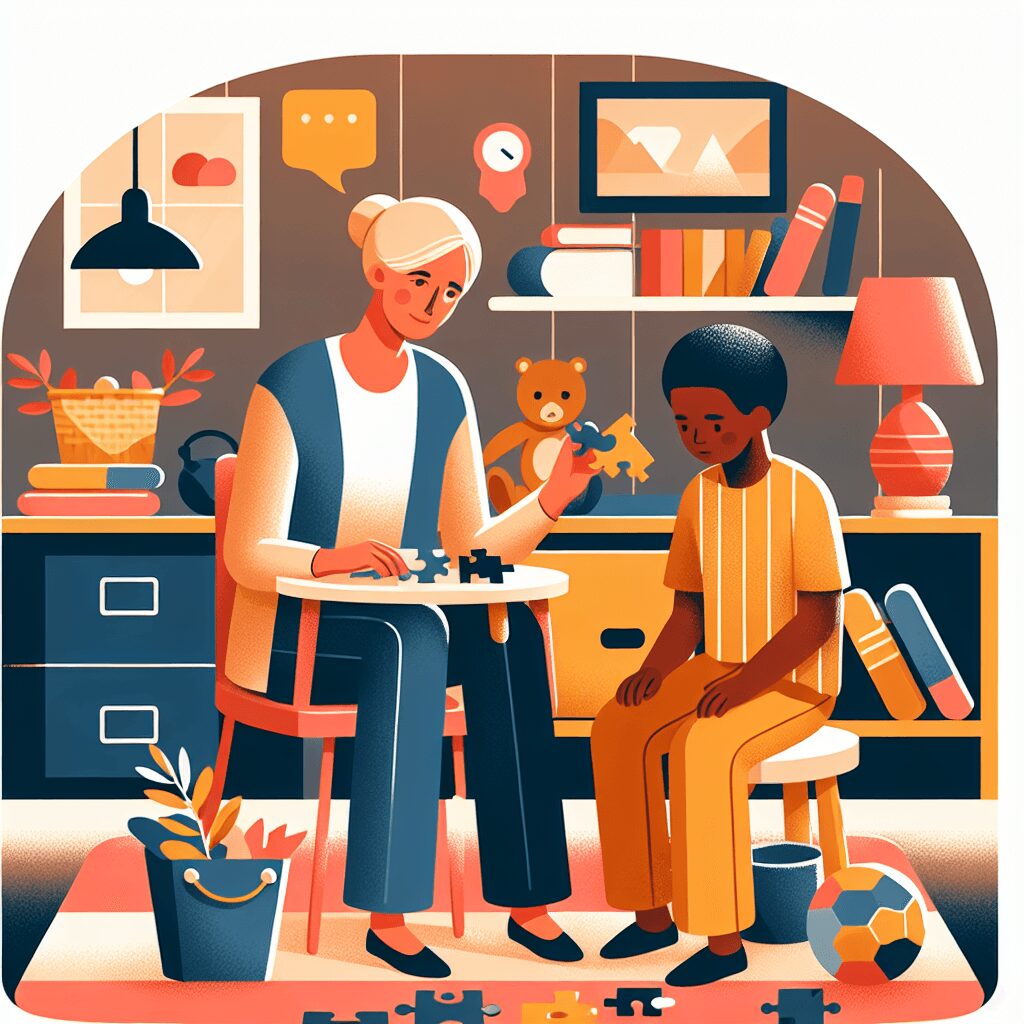Children with Autism Spectrum Disorder (ASD) often face unique challenges in their daily lives. Occupational therapists help these children develop skills to navigate the world around them. Therapy focuses on sensory processing and daily living activities through personalized treatment plans. Incorporating therapy into daily routines can lead to optimal outcomes and improved quality of life for children with ASD.
Let’s discover pediatric occupational therapy for autism and its impact on these children’s lives.
Understanding Pediatric Occupational Therapy for Autism
Pediatric occupational therapy for autism is important. It helps children with autism develop skills for daily life.
Occupational therapists help with sensory differences, social skills, and self-care. They make personalized plans to improve sensory processing, fine motor skills, and social interactions.
Collaboration with other healthcare professionals is essential. Working with speech therapists, educators, and psychologists ensures comprehensive care.
Therapists aim to improve well-being and quality of life by using sensory strategies, play therapy, visual supports, and activities.
Regular sessions help with communication, behavior, and motor skills, leading to better daily outcomes.
Understanding the unique sensory processing in autism is crucial for effective therapy and good results.
What is Pediatric Occupational Therapy for Autism?
Definition and Purpose
Pediatric Occupational Therapy for Autism aims to help individuals with Autism Spectrum Disorder develop important skills for daily life. Therapists focus on sensory processing, fine motor skills, social skills, and independence. They create personalized treatment plans to address specific challenges and goals, ensuring consistency between therapy sessions and daily activities.
The goal of Occupational Therapy for Autism is to improve the quality of life for children with autism by enhancing sensory integration, social interaction, self-care skills, and overall well-being. Therapists use various strategies such as sensory diets, sensory circuits, play therapy, and visual supports to help individuals with autism improve communication, behavior regulation, and participation in daily tasks.
Therapy services also involve addressing sensory sensitivities, sensory overload, and motor control issues and promoting successful social communication interactions to achieve the best possible outcomes for individuals with autism.
Role in Supporting Children with Autism
Occupational therapists support children with autism by addressing challenges in sensory processing, social skills, and independence. They focus on sensory integration, using sensory diets and circuits to improve attention and regulation. Occupational therapists collaborate with other healthcare professionals to provide interventions that promote skill development and enhance quality of life.
Creating personalized treatment plans targets specific skills like fine motor abilities, self-care skills, and social interactions. Through therapeutic activities like play therapy and visual supports, occupational therapists help children with autism manage sensory sensitivities, sensory overload, and motor control.
Evaluation and assessment are integral, tailoring interventions to meet each child’s unique needs. Occupational therapy services aim to support individuals with autism in achieving well-being and optimal functioning by utilizing sensory strategies, communication techniques, and behavioral interventions.
Additionally, therapists work with families and caregivers to provide ongoing support and promote positive outcomes in daily activities and social communication.
Benefits of Pediatric Occupational Therapy for Autism
Improving Daily Occupation
Occupational therapy interventions help individuals with autism improve their daily occupations. Therapists focus on skill development to address challenges in fine motor skills, sensory integration, and social skills.
Implementing sensory strategies like sensory circuits and diets can aid in regulating sensory input and reducing overload. Personalized treatment plans target goals related to self-care and social interactions.
Play therapy, visual supports, and therapeutic activities can enhance communication, behavior, and motor control in individuals with autism.
Occupational therapy supports individuals with autism in achieving independence, enhancing well-being, and improving quality of life. Therapists collaborate with families to offer necessary support and guidance, using sensory information and strategies to deliver effective therapy services for autistic children.
Addressing Sensory Concerns
Children with autism can be greatly affected by sensory concerns. These challenges impact their daily routines, social interactions, and overall happiness. Occupational therapists help by using sensory-based strategies and personalized plans to address these issues. Through sensory integration techniques, therapy focuses on providing input to help regulate the nervous system, improve sensory processing, and develop motor skills.
Visual supports, play therapy, and sensory strategies are used to help manage sensory sensitivities, promote well-being, and foster independence. Assessments play a crucial role in identifying sensory processing differences and setting goals to improve communication, social skills, and self-care. Therapists customize interventions for each child, using sensory circuits and feeding strategies to manage behaviors and motor skills. Coverage for therapy services, like occupational therapy, through health insurance ensures access to these beneficial interventions.
Pediatric Occupational Therapy Goals for Children with Autism
Developing Individualized Treatment Plans
Individualized treatment plans in pediatric occupational therapy for children with autism are important. These plans help address the specific needs and challenges of each child.
Occupational therapists assess sensory processing differences, sensitivities, and motor control to create personalized goals. These goals aim to improve fine motor skills, social skills, independence, and self-care.
Sensory integration is a focus in these plans. Interventions like sensory diets and circuits target sensory overload and provide needed sensory input for regulation.
Therapists use play therapy, visual supports, and activities to aid in daily tasks and social interactions for children with autism. By including sensory strategies in therapy, therapists ensure the child’s nervous system gets the right sensory input for achieving developmental goals.
Evaluation and assessment are crucial for tailoring interventions to meet each child’s unique needs.
Considering factors like health insurance coverage is important for ensuring access to necessary therapies. This helps support the growth and development of children with autism.
Achieving Sensory Integration
Sensory integration in pediatric occupational therapy for children with autism focuses on three main areas:
-
Addressing sensory processing differences
-
Implementing sensory diets
-
Creating sensory circuits
The goal is to enhance attention, focus, and regulation. Occupational therapists also work on various skills, such as personal space, social skills, daily living activities, and safety awareness.
Therapeutic activities like play therapy, visual supports, and sensory strategies are used to ensure consistency between therapy sessions and daily activities. Individualized treatment plans are tailored to each child’s challenges and sensory sensitivities for effective intervention.
Occupational therapy sessions aim to improve fine motor skills, social communication, and independence in self-care skills. Evaluation and assessment are important in developing personalized treatment plans for optimal outcomes.
In therapy sessions, utilizing sensory information, sensory input, and motor control strategies help promote sensory integration and overall well-being in children with autism.
Challenges in Pediatric Occupational Therapy for Autism
Overcoming Communication Barriers
Effective communication techniques are crucial in pediatric occupational therapy for children with autism.
Therapists focus on personalized treatment plans targeting sensory processing, fine motor skills, and social skills.
By using strategies like sensory integration, sensory diets, and social communication interventions, therapists aim to improve the quality of life and independence of autistic children.
These strategies help individuals with autism manage sensory sensitivities, processing differences, and overload during therapy.
Visual supports, play therapy, and therapeutic activities enhance communication, behavior, and motor control.
Creating a supportive environment tailored to each child’s needs can significantly impact the well-being and progress of individuals with autism.
Families should ensure health insurance covers sensory information evaluation and therapy services.
Managing Behavioral Issues
Occupational therapists support individuals with autism by focusing on skill development.
In pediatric occupational therapy, therapists create personalized treatment plans.
These plans address challenges such as sensory processing differences and social skills.
By using sensory integration techniques, therapists help individuals regulate sensory input.
This reduces sensory overload and improves behavior.
Play therapy and visual supports also enhance social communication and independence in daily activities.
Occupational therapists work with other healthcare professionals to ensure comprehensive care for children with autism.
They assess and address sensory sensitivities, motor control, and social interactions.
Through therapeutic activities and sensory strategies, occupational therapists help individuals with autism improve their well-being and quality of life.
This ultimately promotes successful engagement in daily activities and social interactions.
The Role of Occupational Therapists in Autism Spectrum Disorder
Occupational therapists help children with Autism Spectrum Disorder by focusing on skill development. They address challenges like sensory differences through personalized treatment plans.
These therapists collaborate with other healthcare professionals for comprehensive assessment and intervention.
Utilizing sensory integration techniques, sensory diets, and sensory circuits, they aid children in managing sensory overload.
Play therapy, visual supports, and therapeutic activities are used to enhance well-being.
Occupational therapists also work on fine motor skills, self-care, and social communication.
Insurance coverage for therapy services is essential to support individuals with autism in achieving their goals.
Collaboration with Other Healthcare Professionals
Occupational therapists work with a team of healthcare professionals, including speech therapists and psychologists, to support individuals with autism. This teamwork approach covers the various needs of autistic children thoroughly.
The collaboration improves interventions’ effectiveness and fosters better outcomes in skill development, social interaction, and independence.
By working together, therapists can manage communication barriers and behavioral issues. They design individualized treatment plans with sensory strategies, social communication techniques, and behavioral interventions.
This combined effort guarantees that individuals get the needed assistance in dealing with sensory overload, refining sensory processing, enhancing fine motor skills, and learning self-care skills.
Through engaging activities like play therapy and visual aids, therapists strive to enhance the well-being and quality of life of individuals with autism. This approach considers their unique sensory sensitivities and motor challenges.
Coordinating therapy services, securing health insurance coverage, and evaluating sensory information is crucial for delivering holistic care for individuals with autism.
Understanding Sensory Integration in Pediatric Occupational Therapy for Autism
Sensory integration is important in pediatric occupational therapy for kids with autism.
Therapists help with sensory processing, diets, and circuits to improve attention and regulation.
They use strategies to help manage sensory overload and sensitivities.
Therapeutic activities, visual aids, and play therapy are used to improve motor skills, communication, and daily tasks.
Understanding sensory integration helps create personalized plans for skill development and independence.
Therapy can enhance social interactions, self-care, and overall well-being for children with autism.
This approach improves therapy and quality of life for autistic individuals.
Sensory Concerns in Children with Autism: Therapists’ Insights
Children with autism often have sensory concerns like differences in processing, sensitivities, overload, and processing challenges. Occupational therapists help by focusing on sensory integration, diets, and circuits. They create personalized plans targeting various skills like fine motor, social, and self-care. Therapists use visual supports, activities, and play therapy to improve sensory processing and communication.
They also evaluate sensory information, set goals, and provide behavior management tailored to each child’s needs. Health insurance often covers therapy to ensure access to necessary interventions.
In-Home Occupational Therapy for Autism
-
Tailored Environment for Sensory Needs: In-home occupational therapy for children with autism provides a controlled and familiar environment that can significantly reduce sensory overload. The home setting allows therapists to create personalized sensory diets and integrate sensory activities into the child’s daily routine, helping them manage sensitivities and improve their ability to cope with sensory stimuli.
-
Real-Life Skills in a Real-Life Setting: Home-based therapy focuses on developing practical, everyday skills within the context they will be used. For children with autism, this means working on self-care tasks such as dressing, eating, and hygiene in the actual spaces where these activities occur. This contextual learning helps children generalize skills more effectively and increases their ability to perform these tasks independently.
-
Parental Involvement and Training: In-home therapy fosters greater parental involvement, enabling parents to observe and participate in sessions. Therapists can coach parents on specific techniques and interventions tailored to their child’s needs, ensuring consistency and reinforcement of skills throughout the day. This hands-on approach empowers parents to support their child’s development more effectively and can lead to more significant progress.
-
Customizable and Flexible Therapy Plans: Therapists can tailor interventions to fit the unique needs of each child, adapting strategies to their interests and strengths. This individualized approach allows for flexibility in addressing various developmental areas, including motor skills, sensory processing, social interactions, and communication. The home setting also provides the opportunity to incorporate siblings and other family members into therapy sessions, promoting social skills and family bonding.
-
Holistic and Integrated Approach: In-home occupational therapy can seamlessly integrate with other home-based services, such as speech therapy or behavioral interventions, creating a holistic approach to the child’s development. This coordinated care ensures that all aspects of the child’s needs are addressed, promoting overall well-being and more comprehensive progress.
FAQ
What is pediatric occupational therapy for autism?
Pediatric occupational therapy for autism focuses on developing skills like self-care, fine motor, and sensory processing. Therapists use activities like sensory play, handwriting exercises, and social skills training to help children with autism improve their daily functioning.
How can occupational therapy help children with autism?
Occupational therapy can help children with autism by improving their sensory processing, fine motor skills, social interactions, and daily living skills through activities like sensory play, handwriting exercises, and role-playing social scenarios.
What are some common goals of pediatric occupational therapy for autism?
Common goals of pediatric occupational therapy for autism include improving fine motor skills for activities like writing and buttoning buttons, enhancing sensory processing skills for regulating responses to stimuli, increasing social skills for interactions with peers, and promoting independence in daily tasks like dressing and feeding.
What types of activities are used in pediatric occupational therapy for autism?
Sensory activities, play-based activities, fine motor activities, social skills activities, and self-care activities are commonly used in pediatric occupational therapy for autism. Examples include sensory bins, obstacle courses, arts and crafts, fine motor games, turn-taking games, and daily living skills practice.
How can parents support and reinforce occupational therapy techniques at home for their child with autism?
Parents can support occupational therapy at home by creating a sensory-friendly environment, incorporating visual schedules, and using break cards or timers for transitions. Encourage activities that develop fine motor skills like playing with clay or puzzles.
Discover how ABET Life Home Health & Caregiving’s pediatric occupational therapy can make a difference for children with autism. Our in-home services provide personalized, evidence-based interventions to enhance social, sensory, and daily living skills, promoting greater independence and quality of life. Contact us today to learn more about our dedicated and compassionate care for children with autism.








